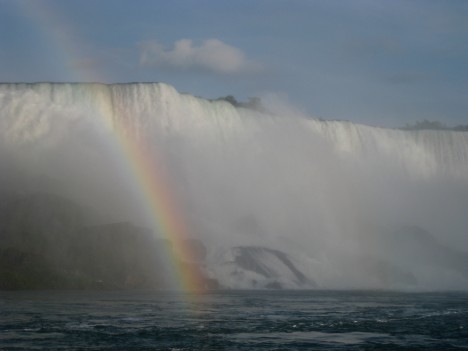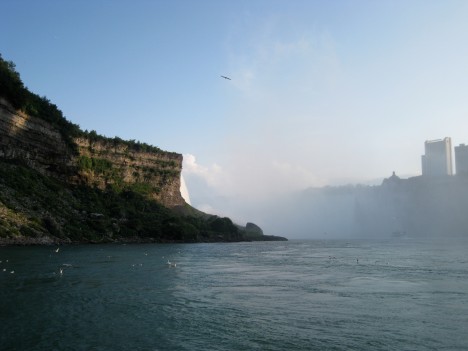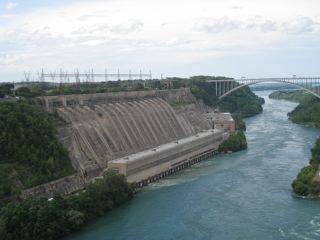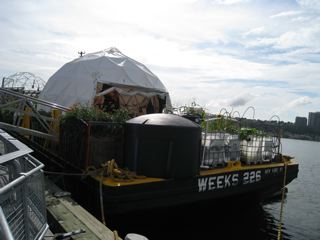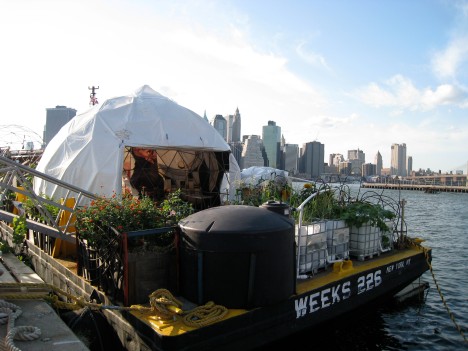
Policy Deliberations- Process Aug 9-17, 2009
Five of us (in Waterways or WW) are in town and we meet on the Waterpod. After touring the vessel, we decide to meet there all week. Our two actions this week will be with children on Friday afternoon and with visitors (mainly adults) all day the following Sunday, determined mainly by the Waterpod group schedule and agreed to by all of us.
 In order to better understand how each of us in WW views the project and our interests, methods, etc. we will pair off for discussions on a rotation on Monday and Tuesday for 1.5 hr each pair followed by a group 0.5 hr summary of our discussions with follow-up questions.
In order to better understand how each of us in WW views the project and our interests, methods, etc. we will pair off for discussions on a rotation on Monday and Tuesday for 1.5 hr each pair followed by a group 0.5 hr summary of our discussions with follow-up questions.
On Monday, there are six of us and we each list a word or phrase that can be used as a focal point and then choose one at random. For example, this author chose “current” which, he pointed out, has two definitions, both of them useful for our deliberations. The one on one discussions covered personal as well as professional information but focused on water as the prime subject. Questions arose such as “What do we want to come away with and what do we want the public to come away with?”, the dilemna of designing demonstrations and emphasizing the principles behind them. In our group meeting, we summarized our one on one conversations which led to further questions and a widening array of possibilities for the actions.
We also covered many facts regarding water usage in NYC, and problems involving potable water in the world and how we might deal with such information. A few possible actions evolved the first day but we felt the process was more important than rushing to a product. Should we include the political and economic aspects of water policy or discuss the privatization of water? Would that take us too far away from our initial purpose. Where is the role of sound?
 On Tuesday, we decided to reduce the one on one time since we had become more familiar with one another on Monday. After only 45 minutes we would meet as a group. That worked well and allowed us to finish the pairings. Discussions included how to motivate the audience, the need to be interactive, follow-up, mapping, multicultural approaches since there are an amazingly large number of ethnic groups in Brooklyn which gives it an international aura. We generate a TO DO list. One of us will do a posting on the blog regarding the process we used this week. Another member will do a posting for the event(s).
On Tuesday, we decided to reduce the one on one time since we had become more familiar with one another on Monday. After only 45 minutes we would meet as a group. That worked well and allowed us to finish the pairings. Discussions included how to motivate the audience, the need to be interactive, follow-up, mapping, multicultural approaches since there are an amazingly large number of ethnic groups in Brooklyn which gives it an international aura. We generate a TO DO list. One of us will do a posting on the blog regarding the process we used this week. Another member will do a posting for the event(s).
By the end of the day we have focused on several activities for the Waterpod. There will be a sound activity, a water tasting with the focus on what is in water, a demonstration on obtaining fresh water from salt water, an interactive map, and interviewing the students to respond to “Water is …”. We have ordered some materials for chemical tests and will probably incorporate them on Sunday.
We also discuss an event planned for September 26, during the DUMBO festival. We will have an action on the Water Taxi but defer discussions until the Waterpod actions are complete.
 On Wednesday, we carefully plan the Friday actions including locations, time schedules, and who will do what. We need to generate sounds and to have appropriate speakers. We design our physical needs and decide who will bring what. For each activity or station, we have one LEAD person, one assisting person and perhaps a third. The locations on the Waterpod are decided.
On Wednesday, we carefully plan the Friday actions including locations, time schedules, and who will do what. We need to generate sounds and to have appropriate speakers. We design our physical needs and decide who will bring what. For each activity or station, we have one LEAD person, one assisting person and perhaps a third. The locations on the Waterpod are decided.
We also discuss the Sunday plan.
On Thursday, some experiments are tested and written informational material to display on the Waterpod is printed. We produce synthetic seawater and redesign some experiments to enhance their artistic components. The discussion includes how to integrate all parts, the science, artistic, and movement. One action is questionable since we need Dry Ice and cannot locate a source so we discuss how it can be oriented if the material is not present. (We do get the Dry Ice on Friday.)
 On Friday, we decide to meet with all the students for a brief introduction, then to divide the students into four groups, that each station will work with the students for 6-8 minutes and then the students will rotate so we always know where the students will be.
On Friday, we decide to meet with all the students for a brief introduction, then to divide the students into four groups, that each station will work with the students for 6-8 minutes and then the students will rotate so we always know where the students will be.
At the conclusion of the action, we decide to meet to review and to plan for Sunday. We will set up the speakers, we will use several chemical tests. We agree upon the activities but question the amount of interaction and interfacing. We will focus on how the Waterpod relates to Brooklyn (NYC) residents. We will have different activities starting on the hour so that a particular activity might occur for a half hour repeatedly starting at 1 pm, 3 pm, and 5 pm, for example.
We are focusing on the conceptual aspect. Assignments are set, each activity will have two people responsible for organizing and performing.
Throughout, the work has been shared and the possible activities have been discussed fully with everyone participating. It is a long process but everyone has had input.
Saturday is used to create and/or accumulate our materials and for other final preparations including hanging the speakers.
 On Sunday, we meet on the Waterpod and arrange locations for our activities. The interactive map is hung and will remain on the Waterpod. It is a full day with lots of interaction with Waterpod people and audience. We agree to summarize on Monday afternoon before our final(?) meeting with the Waterpod group in the evening.
On Sunday, we meet on the Waterpod and arrange locations for our activities. The interactive map is hung and will remain on the Waterpod. It is a full day with lots of interaction with Waterpod people and audience. We agree to summarize on Monday afternoon before our final(?) meeting with the Waterpod group in the evening.
Filed under: Action I - The Waterpod at Brooklyn Bridge Park | Leave a comment »

 On Sunday, October 4th, 11:30 am – 1:30 pm, we did a bike ride in Brooklyn with actions along the way. We met at the Brooklyn Greenway Initiative’s booth at Atlantic Antic, the Brooklyn fall festival in Brooklyn Heights. From there we biked north, through Dumbo, Williamsburg and Greenpoint, to our end stop at Newtown Creek – one of the most polluted waterways in NYC. 15 people showed up on this beautiful sunny Sunday and several more joined us spontaneously along the way. The Brooklyn Waterfront Greenway is designed as bike and walking paths separated from the traffic and will run as close to the water as possible. The project is not completed yet in the part of Brooklyn where we biked, but it is taking shape and you can see the progression of bike paths along the way, moving from a painted line to independent bike lanes.
On Sunday, October 4th, 11:30 am – 1:30 pm, we did a bike ride in Brooklyn with actions along the way. We met at the Brooklyn Greenway Initiative’s booth at Atlantic Antic, the Brooklyn fall festival in Brooklyn Heights. From there we biked north, through Dumbo, Williamsburg and Greenpoint, to our end stop at Newtown Creek – one of the most polluted waterways in NYC. 15 people showed up on this beautiful sunny Sunday and several more joined us spontaneously along the way. The Brooklyn Waterfront Greenway is designed as bike and walking paths separated from the traffic and will run as close to the water as possible. The project is not completed yet in the part of Brooklyn where we biked, but it is taking shape and you can see the progression of bike paths along the way, moving from a painted line to independent bike lanes.  Surrounded by old industrial buildings and fences, there are still not a lot of possibilities to enjoy the actual waterfront in this area, but there are a few openings that permitted us to go all the way to the water, and with the Greenway Initiative’s admirable effort, these openings will expand in the near future.
Surrounded by old industrial buildings and fences, there are still not a lot of possibilities to enjoy the actual waterfront in this area, but there are a few openings that permitted us to go all the way to the water, and with the Greenway Initiative’s admirable effort, these openings will expand in the near future. We made three stops for public actions in parks situated along the East River. This journey was designed as a “best of” collection of our previous actions, showing small pieces from each brought together in a new frame. At the first stop on the bike ride, you could experience dancers on the shore, set to music heard within headphones, and you could have a closer look at the park, the city and the dancers through binoculars. At the second stop, we had a percussionist playing on dry ice with different metal objects. These vibrating sounds enclosed the visual experience of the vapour of the dry ice and the melting of mini glaciers placed in the same area. At our last stop at Newtown Creek, dancers guided the audience into the park through long concrete aisles, where live water music was performed. The pathway and bike tour culminated in a water tasting, where people could compare sips of tap water, spring water and salt water.
We made three stops for public actions in parks situated along the East River. This journey was designed as a “best of” collection of our previous actions, showing small pieces from each brought together in a new frame. At the first stop on the bike ride, you could experience dancers on the shore, set to music heard within headphones, and you could have a closer look at the park, the city and the dancers through binoculars. At the second stop, we had a percussionist playing on dry ice with different metal objects. These vibrating sounds enclosed the visual experience of the vapour of the dry ice and the melting of mini glaciers placed in the same area. At our last stop at Newtown Creek, dancers guided the audience into the park through long concrete aisles, where live water music was performed. The pathway and bike tour culminated in a water tasting, where people could compare sips of tap water, spring water and salt water.


 Human Glacier is a literal enactment of the melting of a glacier. This collaboration with Paul D. Miller is an extension of Waterways, a project integrating architecture, ecology and dance, with the participation of Emma Nordanfors, Klara Elenius, and Karina Dichov-Lund of E.K.K.O, Lucy Hg of the League of Imaginary Scientists, Annie Kwon, David Garin and Matt McBane. A partial list of dancers includes: Frida Danell, Irene Hsi, Ea Verdoner Jaocbsen, Johanna Moritz, Kristina Skovby, Madeleine Söderberg, Carmela Torchia, and Marie Vestermark. This performance is supported by iLAND, Inc, The Danish Arts Council, and the Danish Actors Association.
Human Glacier is a literal enactment of the melting of a glacier. This collaboration with Paul D. Miller is an extension of Waterways, a project integrating architecture, ecology and dance, with the participation of Emma Nordanfors, Klara Elenius, and Karina Dichov-Lund of E.K.K.O, Lucy Hg of the League of Imaginary Scientists, Annie Kwon, David Garin and Matt McBane. A partial list of dancers includes: Frida Danell, Irene Hsi, Ea Verdoner Jaocbsen, Johanna Moritz, Kristina Skovby, Madeleine Söderberg, Carmela Torchia, and Marie Vestermark. This performance is supported by iLAND, Inc, The Danish Arts Council, and the Danish Actors Association.
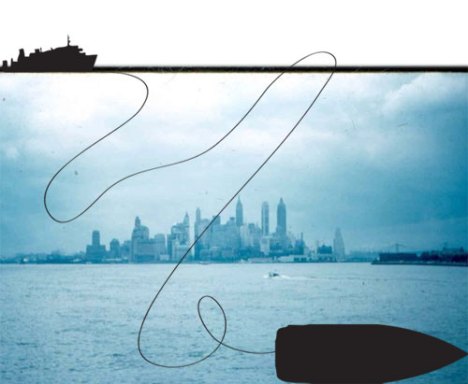
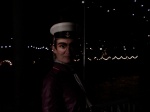 While entering the boat, participants were handed binoculars to be used to get a closer look at the city and the landscape of light that surrounding it and the boat. These cruises took place from sunset at 7 pm until the last ride that ended at 9 pm. Complementary to this architectonic experience, the boat “danced” in a choreographed route, twirling and making unusual movements as a water soundtrack played in the boat’s speaker system. Together, these simple components created an intense experience of being ON the water IN the city. Finally, getting off the boat, out to the pier again – the captains applauded the journey and welcomed the audience back from their floating reality to a more grounded one.
While entering the boat, participants were handed binoculars to be used to get a closer look at the city and the landscape of light that surrounding it and the boat. These cruises took place from sunset at 7 pm until the last ride that ended at 9 pm. Complementary to this architectonic experience, the boat “danced” in a choreographed route, twirling and making unusual movements as a water soundtrack played in the boat’s speaker system. Together, these simple components created an intense experience of being ON the water IN the city. Finally, getting off the boat, out to the pier again – the captains applauded the journey and welcomed the audience back from their floating reality to a more grounded one. To be on East River at night, on a boat that pirouettes and weaves through the water, with Manhattan and Brooklyn and their connecting bridges as a spectacular backdrop, was a strong physical and visual experience.
To be on East River at night, on a boat that pirouettes and weaves through the water, with Manhattan and Brooklyn and their connecting bridges as a spectacular backdrop, was a strong physical and visual experience.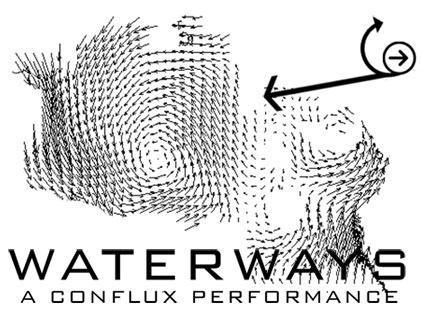
 Reflections:
Reflections: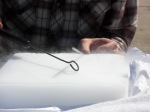 They had a brief meeting with something they didn’t expect and then moved on. Some laughed. Some got annoyed that people would stop and face them or stare in there direction, because something was going on right behind were they were sitting. These small interactions were something we didn’t really count on but they turned out to be maybe the best part of the day.
They had a brief meeting with something they didn’t expect and then moved on. Some laughed. Some got annoyed that people would stop and face them or stare in there direction, because something was going on right behind were they were sitting. These small interactions were something we didn’t really count on but they turned out to be maybe the best part of the day. Along with the different actions we planed out a structure for viewing them from a center station. But as it turned out the structure didn’t really function the way we thought it would. People viewing from there, were engaging in completely their own ways. Some would stay for a long time just watching the city across the river through the binoculars handed out to them. Others would stay and listen to the different water scores in the headphones. They searched for and found things that excited them. But many completely missed several of the actions we planed for them to experience as part of a whole. In that way the piece ended up being much more open than it was thought out to be from the beginning. And I guess in many ways that lines up with the whole idea of working site specific.
Along with the different actions we planed out a structure for viewing them from a center station. But as it turned out the structure didn’t really function the way we thought it would. People viewing from there, were engaging in completely their own ways. Some would stay for a long time just watching the city across the river through the binoculars handed out to them. Others would stay and listen to the different water scores in the headphones. They searched for and found things that excited them. But many completely missed several of the actions we planed for them to experience as part of a whole. In that way the piece ended up being much more open than it was thought out to be from the beginning. And I guess in many ways that lines up with the whole idea of working site specific. You get gifts you didn’t know was there – through the interactions with the given surroundings and you have to deal with surprises – in a more or less controlled way. You never know when a sleeping drunk is in the place where you are supposed to perform. Or a flock of birds have chosen to use the concrete platform you planned to draw on, as their personal bathroom, so you have to clean up bird shit before you can get to it. Basically you need to expect any thing – and I guess that is what is so fascinating about site-specific work. You have to go with the flow and just see where the experience takes you.
You get gifts you didn’t know was there – through the interactions with the given surroundings and you have to deal with surprises – in a more or less controlled way. You never know when a sleeping drunk is in the place where you are supposed to perform. Or a flock of birds have chosen to use the concrete platform you planned to draw on, as their personal bathroom, so you have to clean up bird shit before you can get to it. Basically you need to expect any thing – and I guess that is what is so fascinating about site-specific work. You have to go with the flow and just see where the experience takes you.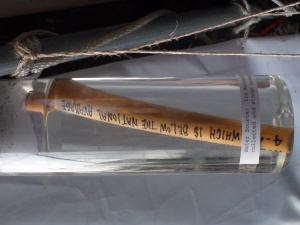
 The wall consisted of three main components: a map of New York, a diagram of water systems, and a water testing station. The map of New York was made of historical maps from throughout New York’s history layered upon one another to create a new map that visualized the layers of City’s history. On this map the public was given the opportunity to place color-coded pins marking the locations of various water resources and their interactions with them: a pool, a fire hydrant, where they last flushed, where they had a refreshing glass of water. By the end of the day, the result was a new whimsical mapping of the public’s water usage.
The wall consisted of three main components: a map of New York, a diagram of water systems, and a water testing station. The map of New York was made of historical maps from throughout New York’s history layered upon one another to create a new map that visualized the layers of City’s history. On this map the public was given the opportunity to place color-coded pins marking the locations of various water resources and their interactions with them: a pool, a fire hydrant, where they last flushed, where they had a refreshing glass of water. By the end of the day, the result was a new whimsical mapping of the public’s water usage.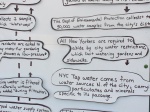 The diagram of water systems was the most direct expression of the installation’s concept of relating the Waterpod to the City. On it the different stages of water usage on Waterpod and in the City were drawn parallel to one another illustrating the relationship of water collection, storage, purification, usage, sewage treatment, and grey water use. It was noted that while the two use parallel systems, the Waterpod is on a much more strictly rationed supply and makes much more efficient use of its grey water.
The diagram of water systems was the most direct expression of the installation’s concept of relating the Waterpod to the City. On it the different stages of water usage on Waterpod and in the City were drawn parallel to one another illustrating the relationship of water collection, storage, purification, usage, sewage treatment, and grey water use. It was noted that while the two use parallel systems, the Waterpod is on a much more strictly rationed supply and makes much more efficient use of its grey water.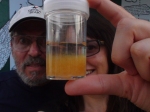 The water testing station provided the public the opportunity to witness and participate in a variety of chemical tests on the water of the Waterpod and New York. These tests, including pH, oxgen content and others were done on water samples from the different stages of water usage on the barge and from different sites of interest in Brooklyn: Newtown Creek, the East River and tap water. David Garrin led these tests with participation from the public and provided scientific background information on water usage in the two environments.
The water testing station provided the public the opportunity to witness and participate in a variety of chemical tests on the water of the Waterpod and New York. These tests, including pH, oxgen content and others were done on water samples from the different stages of water usage on the barge and from different sites of interest in Brooklyn: Newtown Creek, the East River and tap water. David Garrin led these tests with participation from the public and provided scientific background information on water usage in the two environments.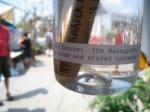 The installation in the dome consisted of two components: hanging water bottles and a speaker installation. The hanging water bottles contained information about New York’s water usage written on pieces of wood floating in water samples from the different stages of water usage on the Waterpod. By placing the samples of the Waterpod’s water in identical hanging bottles, water that is often not seen in the water system of the barge was made visible to contemplate aesthetically. The information about the City’s water system floating in this water prompted the viewer to contemplate the relationship between the two water systems.
The installation in the dome consisted of two components: hanging water bottles and a speaker installation. The hanging water bottles contained information about New York’s water usage written on pieces of wood floating in water samples from the different stages of water usage on the Waterpod. By placing the samples of the Waterpod’s water in identical hanging bottles, water that is often not seen in the water system of the barge was made visible to contemplate aesthetically. The information about the City’s water system floating in this water prompted the viewer to contemplate the relationship between the two water systems. The sound installation in the consisted of 8 separate channels sent to eight separate speakers spaced symmetrically around the walls of the dome. The sound sources for the installation were recordings of the different water sounds of the Waterpod. These sounds ranged from the delicate rhythmic dripping of the hydroponic irrigation system to the intense downpour of rain on the dome’s vinyl siding. The sounds were arranged throughout the space and over the course 20 minutes to create a variety of effects: from the disorienting effect of the recorded sound of the movement of the barge in the water clashing with the barge’s actual movements, to the animal-like disembodied sounds of the foot water pump, to the realistic sounds of rain. The overall effect was to draw the public’s attention to the particular acoustics of the geodesic dome, and to draw their attention to the sounds of the barge’s water system making them more aware of the Waterpod’s water sytem.
The sound installation in the consisted of 8 separate channels sent to eight separate speakers spaced symmetrically around the walls of the dome. The sound sources for the installation were recordings of the different water sounds of the Waterpod. These sounds ranged from the delicate rhythmic dripping of the hydroponic irrigation system to the intense downpour of rain on the dome’s vinyl siding. The sounds were arranged throughout the space and over the course 20 minutes to create a variety of effects: from the disorienting effect of the recorded sound of the movement of the barge in the water clashing with the barge’s actual movements, to the animal-like disembodied sounds of the foot water pump, to the realistic sounds of rain. The overall effect was to draw the public’s attention to the particular acoustics of the geodesic dome, and to draw their attention to the sounds of the barge’s water system making them more aware of the Waterpod’s water sytem.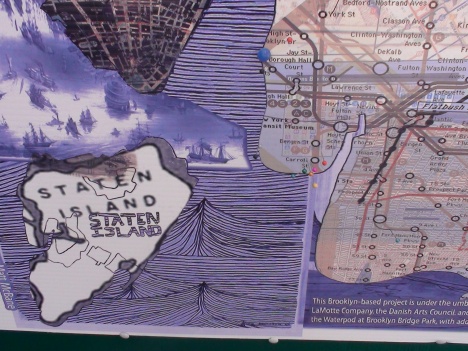

 In order to better understand how each of us in WW views the project and our interests, methods, etc. we will pair off for discussions on a rotation on Monday and Tuesday for 1.5 hr each pair followed by a group 0.5 hr summary of our discussions with follow-up questions.
In order to better understand how each of us in WW views the project and our interests, methods, etc. we will pair off for discussions on a rotation on Monday and Tuesday for 1.5 hr each pair followed by a group 0.5 hr summary of our discussions with follow-up questions. On Tuesday, we decided to reduce the one on one time since we had become more familiar with one another on Monday. After only 45 minutes we would meet as a group. That worked well and allowed us to finish the pairings. Discussions included how to motivate the audience, the need to be interactive, follow-up, mapping, multicultural approaches since there are an amazingly large number of ethnic groups in Brooklyn which gives it an international aura. We generate a TO DO list. One of us will do a posting on the blog regarding the process we used this week. Another member will do a posting for the event(s).
On Tuesday, we decided to reduce the one on one time since we had become more familiar with one another on Monday. After only 45 minutes we would meet as a group. That worked well and allowed us to finish the pairings. Discussions included how to motivate the audience, the need to be interactive, follow-up, mapping, multicultural approaches since there are an amazingly large number of ethnic groups in Brooklyn which gives it an international aura. We generate a TO DO list. One of us will do a posting on the blog regarding the process we used this week. Another member will do a posting for the event(s). On Wednesday, we carefully plan the Friday actions including locations, time schedules, and who will do what. We need to generate sounds and to have appropriate speakers. We design our physical needs and decide who will bring what. For each activity or station, we have one LEAD person, one assisting person and perhaps a third. The locations on the Waterpod are decided.
On Wednesday, we carefully plan the Friday actions including locations, time schedules, and who will do what. We need to generate sounds and to have appropriate speakers. We design our physical needs and decide who will bring what. For each activity or station, we have one LEAD person, one assisting person and perhaps a third. The locations on the Waterpod are decided. On Friday, we decide to meet with all the students for a brief introduction, then to divide the students into four groups, that each station will work with the students for 6-8 minutes and then the students will rotate so we always know where the students will be.
On Friday, we decide to meet with all the students for a brief introduction, then to divide the students into four groups, that each station will work with the students for 6-8 minutes and then the students will rotate so we always know where the students will be. On Sunday, we meet on the Waterpod and arrange locations for our activities. The interactive map is hung and will remain on the Waterpod. It is a full day with lots of interaction with Waterpod people and audience. We agree to summarize on Monday afternoon before our final(?) meeting with the Waterpod group in the evening.
On Sunday, we meet on the Waterpod and arrange locations for our activities. The interactive map is hung and will remain on the Waterpod. It is a full day with lots of interaction with Waterpod people and audience. We agree to summarize on Monday afternoon before our final(?) meeting with the Waterpod group in the evening.

